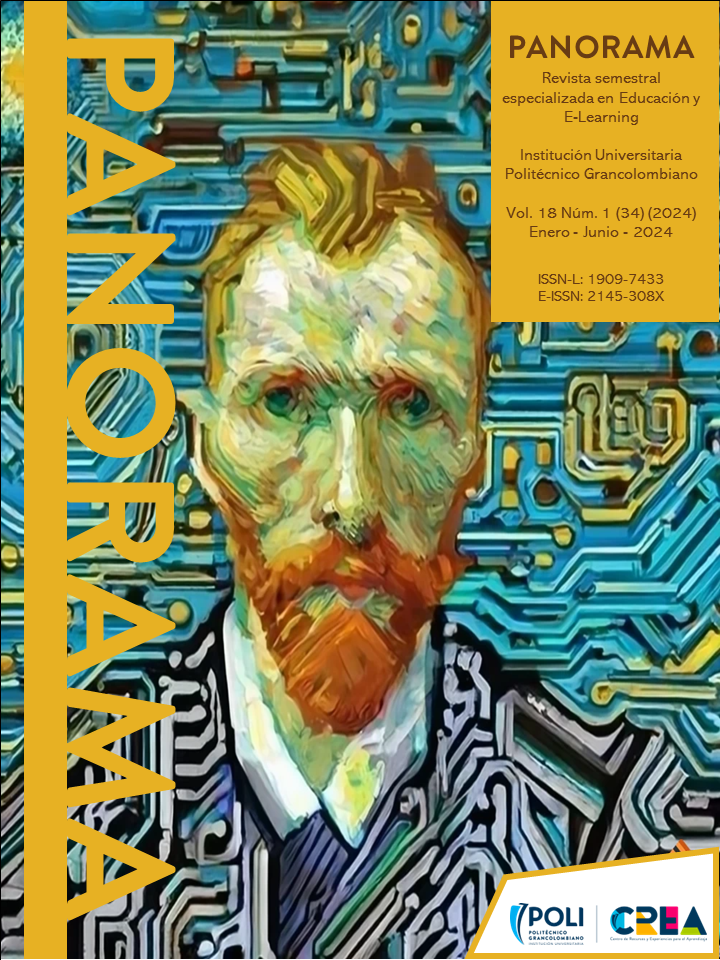Abstract
The ninth-grade students of the El Sagrado Corazón de Jesús Hermanas Bethlemitas School (Bucaramanga-Colombia) present low academic performance in spatial geometric mathematical thinking. In this context, a didactic strategy supported by an augmented reality application was designed, from a mixed approach, descriptive scope, and type of quasi-experimental design in groups 9-1 and 9.2. To do this, a methodology was followed that included the diagnosis, designs, implementation, and evaluation phases. The results of the entry and exit tests were 60 and 85 points respectively; the student t hypothesis test with a significance level of 5% yielded values lees than 0.1%, rejecting the null hypothesis. In this sense, there is a statically significant difference between the entry and exit test. Consequently, it is concluded that the pedagogical intervention generated a significant effect in strengthening mathematical and geometric spatial thinking in ninth grade students.
References
Amézquita-Nidia, L. (2021). Realidad aumentada como recurso didáctico para el aprendizaje significativo de la geometría espacial. Universidad de Cartagena (programa de Maestría en Recursos Digitales Aplicados a la Educación). p 179.
Arias-Velandia, N., Rincón-Báez, W., Rojas-Tolosa, S. M., Moreno-Jiménez, Y. J., & Daza-Orozco, C. E. (2022). Bibliographical Overview on Science Activities, Learning Achievement and Shaping of Scientific Vocations in Early, Elementary, Secondary and High School Education. URL: http://dx. doi. org/10.2139/ssrn, 4071009.
Blázquez Sevilla, A. (2017). Realidad aumentada en Educación. Monografía (Manual). Rectorado (UPM).
Hernández-Sampieri, R.; Mendoza Torres, C.P.(2018). Metodología de la investigación las rutas cuantitativa, cualitativa y mixta. Edamsa Impresiones, S.A. de C.V.
Daza-Orozco, C. E., Norman-Acevedo, E., Cera-Ochoa, R. A., & Acosta-Triviño, R. (2022). Experiencias de investigación inspiradoras. Iniciación Científica. https://iniciacioncientifica.com/editorial/index.php/libros/article/view/2
Islas Torres, C., y Delgadillo Franco, O. (2016). La inclusión de TIC por estudiantes universitarios: una mirada desde el conectivismo. Apertura, 8(2), 116-129.
Islas-Torres, C. (2021). Conectivismo y neuroeducación: transdisciplinas para la formación en la era digital. Revista científica multidisciplinaria de prospectiva. 28 (1) 1-1.
Jiménez, I. El triángulo lógico: una ecuación didáctica emergente para aprender metodología de la investigación. Chía, Cundinamarca: Universidad de La Sabana. 2020.
Martínez, O., Mejía, E, Ramírez, W, & Rodríguez, T. (2021). Incidencia de la realidad aumentada en los procesos de aprendizaje de las funciones matemáticas. Información tecnológica, 32(3), 3-14. https://dx.doi.org/10.4067/S0718-07642021000300003
Medina Herrera, L. M., Aguilar Sánchez, G., Angelo Notarantonio, L. A., Ruiz Loza, S., Alencastre Miranda, M., Muñoz Gómez, L., ... & Cyril Michel, L. (2015). Visualización matemática con realidad aumentada: Cálculo multivariado.
Ministerio de Educación Nacional de Colombia. (1998). Lineamientos curriculares en matemáticas. Ministerio de Educación Nacional de Colombia.
OECD - Organisation for Economic Co-operation and Development (2023). PISA 2022 Results (Volume I): The State of Learning and Equity in Education, PISA, OECD Publishing, Paris, https://doi.org/10.1787/53f23881-en.
Pérez-Ortega, I., (2017). Creación de Recursos Educativos Digitales: Reflexiones sobre Innovación Educativa con TIC. Revista Internacional de Sociología de la Educación, 6(2), 243-268.
Reyero Sáez, M. (2019). La educación constructivista en la era digital. Revista Tecnología, Ciencia Y Educación, (12), 111–127. https://doi.org/10.51302/tce.2019.244
Rodríguez Medina, J. C. (2017). El construccionismo como modelo pedagógico para el uso de las tics en la educación (Doctoral dissertation, Universidad Santo Tomás).
Terán, K. (2012). Realidad aumentada, sus desafíos y aplicaciones para el e-learning. Universidad Politécnica Territorial de los Altos Mirandinos Cecilio Acosta.
Yoza Zambrano, C. A., y Moya Martínez, M. E. (2019). El modelo constructivista, la tecnología y la innovación educativa. Atlante Cuadernos de Educación y Desarrollo, (agosto).

This work is licensed under a Creative Commons Attribution-NonCommercial-NoDerivatives 4.0 International License.
Copyright (c) 2024 Panorama





